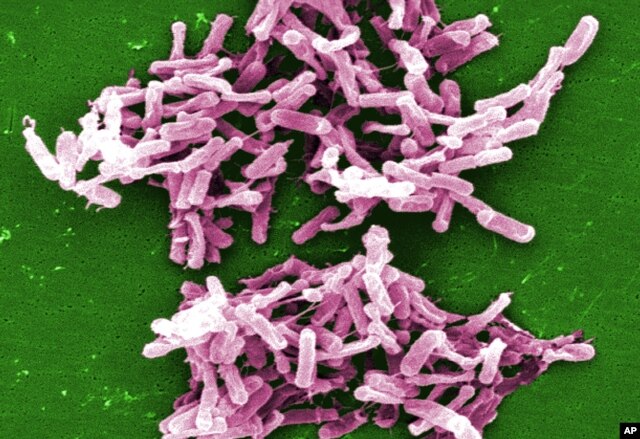
American Peggy Lillis thought she had a stomach virus. But her condition was much worse than she thought. She had become infected with what researchers call a “superbug” -- clostridium difficile-related infection or “C. difficile.” It is one of the fastest-growing superbugs. Ms. Lillis had been given antibiotics after receiving care for her teeth. Doctors believe the medicine killed good bacteria in her body. They believe this made it easy for her to be infected with C. difficile. She died within days of being infected.

Fifteen-year-old Nile Moss of California went to a hospital for medical tests. Within a few days, he died of pneumonia. The young man had become sick with methicillin-resistant staphylococcus aureus, or MRSA. It is known as the “hospital superbug,” because people who get MRSA are often infected with it when they are in a hospital.
Joshua Nahum went to the hospital after he was injured while sky-diving. His health started to improve during his hospitalization. But he became infected with a virus. Very few or no antibiotics have been developed to fight the “gram-negative” infection from which he suffered. Like Peggy Lillis and Nile Moss, Joshua Nahum also died.
Family members of the three went to a meeting last week at the White House. Experts gathered there to talk about how to fight infections that resist antibiotics.
Dr. Tom Frieden is the head of the U.S. Centers for Disease Control and Prevention. He spoke about the victims of improper use of antibiotics. He also talked about the lack of drugs to treat some infections.
The Centers for Disease Control estimates that about 50 percent of all antibiotic prescriptions are not necessary. It says the willingness of doctors to give such drugs to patients increases the risk that people will get C. difficile or other hard-to-fight infections.
The overuse and misuse of antibiotics leads to stronger bacteria -- ones that can resist medical treatments. The CDC estimates these drug-resistant bacteria cause two million infections and about 23,000 deaths each year in the United States.
Dr. Frieden said that if antibiotics are no longer effective, doctors will not be able to care for the 600,000 Americans who are treated for cancer each year. And doctors will not be able to help people who need new organs or who just need routine medical care.
He told the gathering that if changes are not made to the way antibiotics are prescribed, the time may come again when, in his words, “simple infections could kill.”
In March, President Barack Obama launched a five-year, $120 billion program to fight antibiotic-resistant bacteria. The plan calls for officials to more closely watch for outbreaks of antibiotic-resistant infections in human beings and animals. It also calls for testing to identify antibiotic-resistant bacteria. And it provides money to help researchers more quickly develop new antibiotics and vaccines.
Representatives of more than 150 food companies, stores, health care systems and drug makers attended the White House gathering. They talked about ways to limit the amount of antibiotics given to humans and livestock or added to animal feed.
Tyson Foods has promised to stop giving human antibiotics to its chickens by September 2017. Another company, Walmart, is asking its food suppliers to use antibiotics only to treat and prevent disease in animals, not to help them grow larger.
Frank Yiannas is Walmart’s Vice President of Food Safety. He said the company is asking its suppliers to give Walmart a report every year telling how they are using antibiotics, how much they are using and why.
Intermountain Healthcare said it plans to reduce the misuse of antibiotics in patients who do not require hospitalization. The group said it will cut their use by 50 percent for people with upper-body infections.
Before the gathering, President Obama signed an executive order. It directs all federal agencies to ensure that the meat sold in their restaurants comes from suppliers with responsible antibiotic use policies.
Lisa Monaco is an advisor to the president. She said the government is taking other steps to fight the development of antibiotic-resistant bacteria. She said all hospitals for military veterans and other federal centers must follow CDC rules on antibiotic use.
Ms. Monaco said the most effective way to fight the development of antibiotic-resistant bacteria is to reduce the use of antibiotics.
She said the United States may not be taking the threat of antibiotic-resistant bacteria seriously enough. But she said it is, in her words, “a serious risk to the health and security of people everywhere. And we all have to take steps to improve the way we are using antibiotics today so they will be effective when we truly need them in the future.”
I’m Christopher Jones-Cruise.
VOA White House Correspondent Aru Pande reported this story. Christopher Jones-Cruise adapted it into VOA Learning English. George Grow was the editor.
Words in This Story
superbug – n. an infection that can be passed from one person to another and is difficult to treat
pneumonia – n. a serious disease that affects the lungs and makes breathing difficult
prescription – n. a written message from a doctor that tells a patient to use a medicine
routine – adj. a way of doing things in an exact or particular order
outbreak – n. a sudden increase of disease
Is your country working to reduce antibiotic use? We want to hear from you. Write your thoughts in the comments section.


